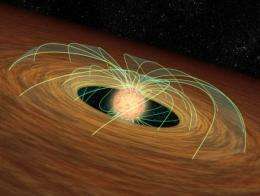Slowing down stars

One of the long standing challenges in stellar astronomy, is explaining why stars rotate so slowly. Given their large masses, as they collapsed to form, they should spin up to the point of flying apart, preventing them from ever reaching the point that they could ignite fusion. To explain this rotational braking, astronomers have invoked an interaction between the forming star’s magnetic field, and forming accretion disc. This interaction would slow the star allowing for further collapse to take place. This explanation is now over 40 years old, but how has it held up as it has aged?
One of the greatest challenges to testing this theory is for it to make predictions that are directly testable. Until very recently, astronomers were unable to directly observe circumstellar discs around newly formed stars. In order to get around this, astronomers have used statistical surveys, looking for the presence of these discs indirectly. Since dust discs will be warmed by the forming star, systems with these discs will have extra emission in the infrared portion of the spectra. According to the magnetic braking theory, young stars with discs should rotate more slowly than those without. This prediction was confirmed in 1993 by a team of astronomers led by Suzan Edwards at the University of Massachusetts, Amherst. Numerous other studies confirmed these general findings but added a further layer to the picture; stars are slowed by their discs to a period of ~8 days, but as the discs dissipate, the stars continue to collapse, spinning up to a period of 1-2 days.
Another interesting finding from these studies is that the effects seem to be most pronounced for stars of higher mass. When similar studies were conducted on young stars in the Orion and Eagle nebulae, researchers found that there was no sharp distinction between stars with or without disks for low mass stars. Findings such as these have caused astronomers to begin questioning how universal the magnetic disc braking is.
One of the other pieces of information with which astronomers could work was the realization around 1970 that there was a sharp divide in rotational speeds between high mass stars and lower mass ones at around the F spectral class. This phenomenon had been anticipated nearly a decade earlier when Evry Schatzman proposed that the stellar wind would interact with the star’s own magnetic field to create drag. Since these later spectral class stars tended to have more active magnetic fields, the braking effect would be more important for these stars.
Thus astronomers now had two effects which could serve to slow rotation rates of stars. Given the firm theoretical and observational evidence for each, they were both likely “right”, so the question became which was dominant in which circumstance. This question is one with which astronomers are still struggling.
To help answer the question, astronomers will need to gather a better understanding of how much each effect is at work in individual stars instead of simply large population surveys, but doing so is tricky. The main method employed to examine disc locking is to examine whether the inner edge of the disc is similar to the radius at which an object in a Keplarian orbit would have a similar angular velocity to the star. If so, it would imply that the star is fully locked with the disc’s inner edge. However, measuring these two values is easier said than done. To compare the values, astronomers must construct thousands of potential star/disc models against which to compare the observations.
In one recent paper astronomers used this technique on IC 348, a young open cluster. Their analysis showed that ~70% of stars were magnetically locked with the disc. However, the remaining 30% were suspected to have inner disc radii beyond the reach of the magnetic field and thus, unavailable for disc braking. However, these results are somewhat ambiguous. While the strong number of stars tied to their discs does support the disc braking as an important component of the rotational evolution of the stars, it does not distinguish whether it is presently a dominant feature. As previously stated, many of the stars could be in the process of evaporating the discs, allowing the star to again spin-up. It is also not clear if the 30% of stars without evidence of disc locking were locked in the past.
Research like this is only one piece to a larger puzzle. Although the details of it aren’t fully fleshed out, it is readily apparent that these magnetic braking effects, both with discs and stellar winds, play a significant effect on slowing the angular speed of stars. This runs completely contrary to the frequent Creationist claim that “[t]here is no know [sic] mechanical process which could accomplinsh [sic] this transfer of momentum”.
Source: Universe Today




















